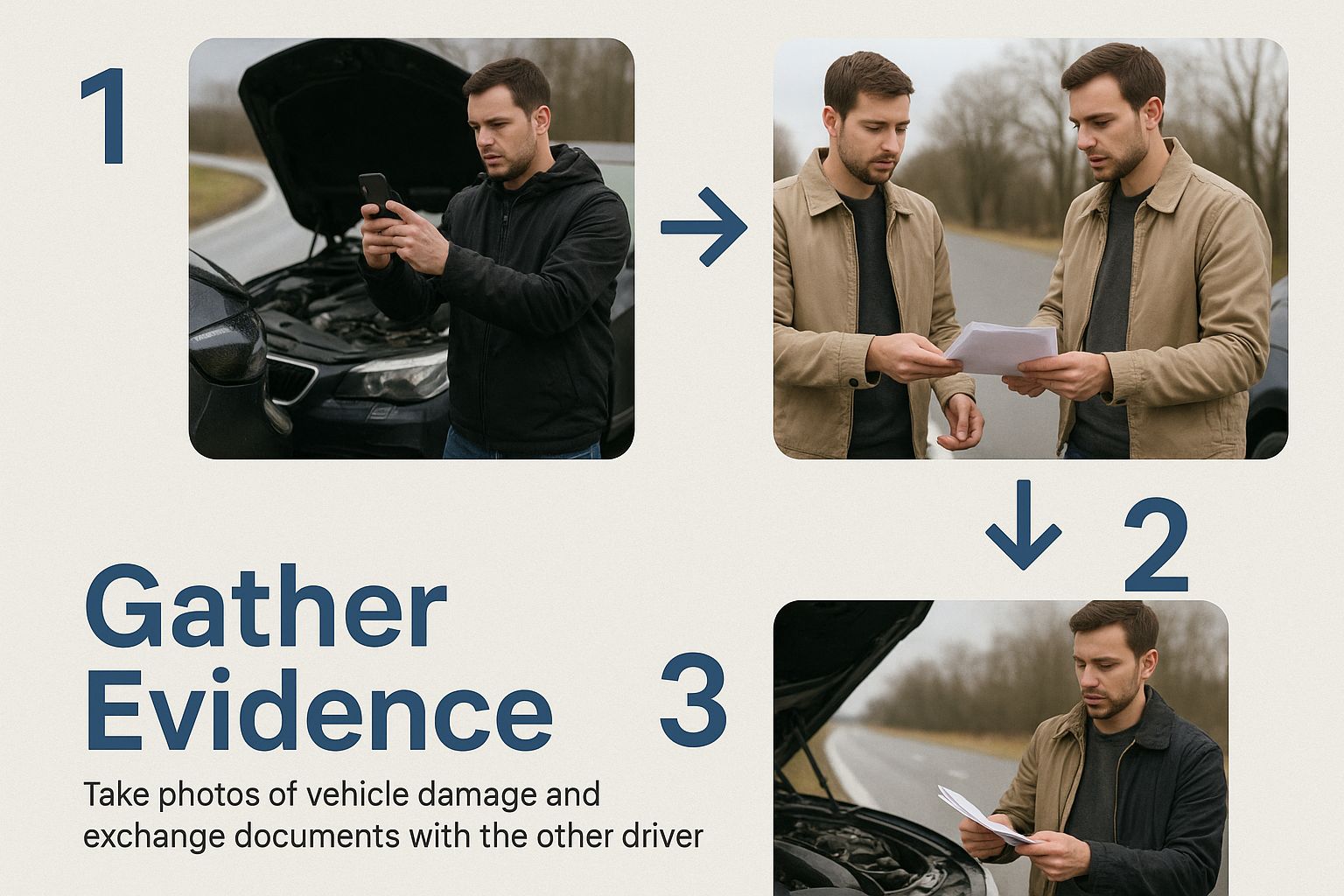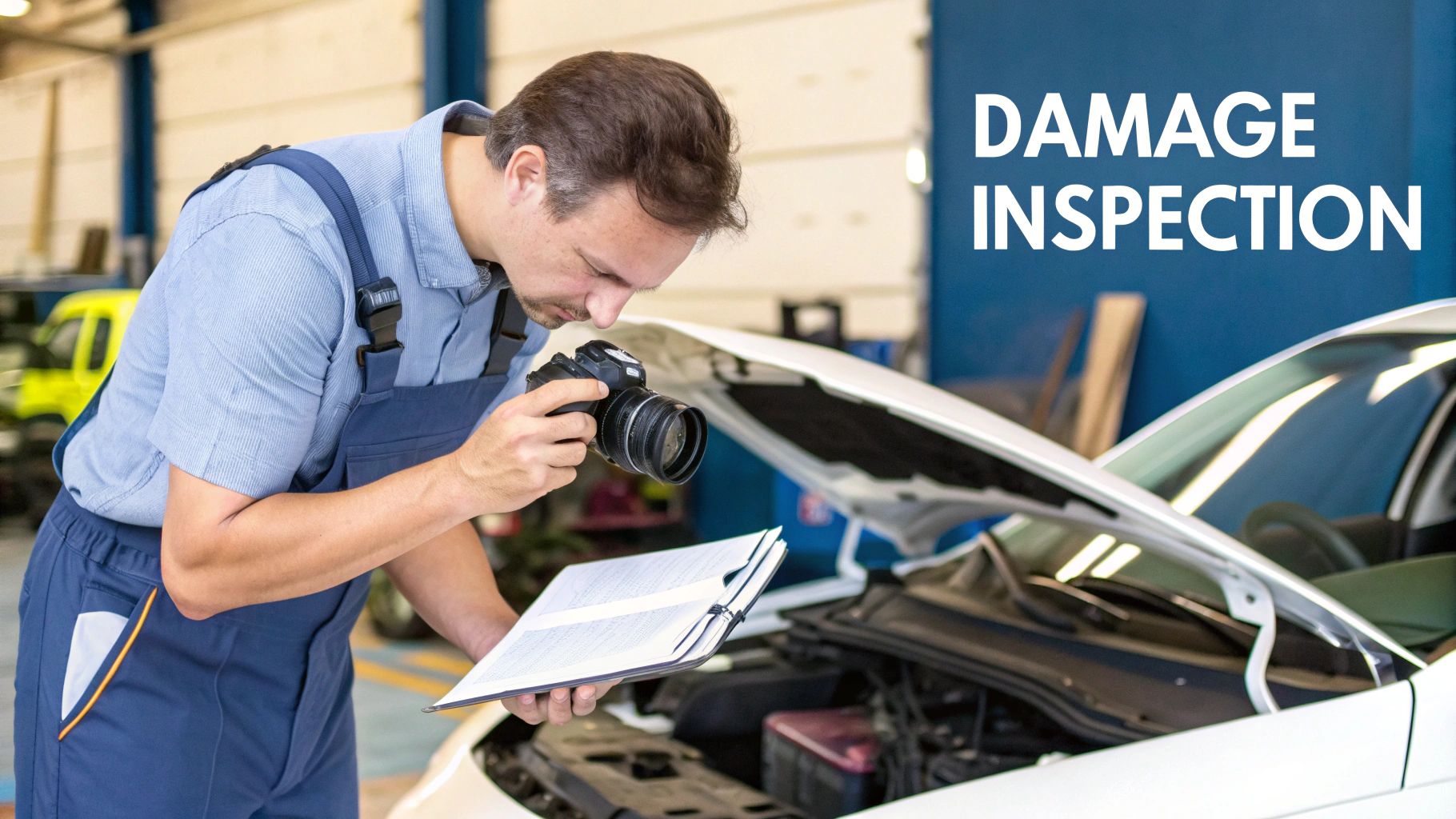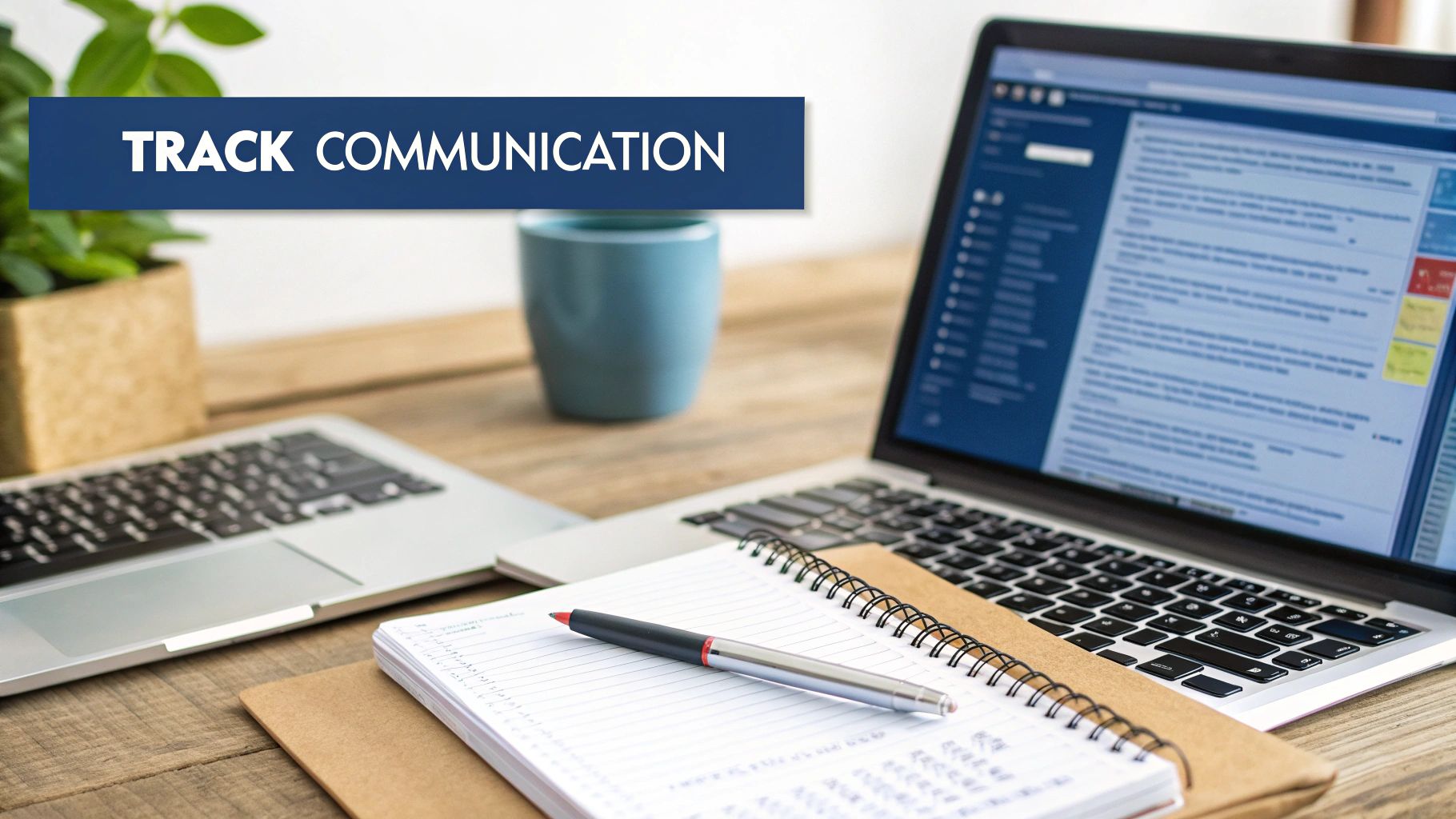Believe it or not, the process of filing an auto insurance claim doesn't start with a phone call to your agent. It begins the second you're in an accident, right there at the scene. What you do in those first few chaotic minutes—gathering evidence, exchanging information, and talking to the police—lays the entire foundation for a smooth and successful claim.
What to Do Immediately After a Car Accident
The aftermath of a car accident is disorienting, to say the least. But the steps you take right then and there are absolutely critical for building a solid insurance claim later on.
First things first: safety. Before you do anything else, check on yourself and your passengers. Are there any injuries? Then, if you can, check on the people in the other vehicle.
If the cars are still drivable and it’s safe, pull them over to the shoulder or out of the main flow of traffic. This one simple move can prevent a secondary accident and keep everyone safer.
Document Everything at the Scene
Your smartphone is your best friend after a collision. Don't just take a couple of quick pictures of the dented fender. You need to become a bit of a detective.
Get photos from every conceivable angle. Take wide shots that show the entire intersection, the position of the cars, and any relevant traffic signs. Get close-ups of the damage to both vehicles. Look for skid marks on the pavement or debris from the crash. Even capturing the weather conditions can be helpful. This visual evidence tells a story that your words alone never could.
I always tell my clients to think of it this way: you are gathering evidence for your future self and for an insurance adjuster who wasn't there. The more detail you capture now, the fewer questions and headaches you'll have down the road when you file.
Next up is exchanging information with the other driver. It’s important to stay calm and cooperative, but this isn't the time to apologize or discuss who was at fault. Just stick to the facts.
To help you remember what to collect when you're likely feeling flustered, here's a quick checklist.
Essential On-Scene Accident Information Checklist
This table is a quick reference for collecting the critical details at the accident scene that will support your insurance claim.
| Information Category | Specific Details to Collect | Why It Matters for Your Claim |
|---|---|---|
| Driver Information | Full name, current address, phone number, and driver's license number. | This confirms the identity of the person involved and provides a direct line of contact. |
| Insurance Details | Insurance company name, policy number, and the agent's contact information. | Your insurer needs this to initiate contact with the other party's insurance for liability and payment discussions. |
| Vehicle Information | Make, model, year, color, and license plate number of all vehicles involved. | This provides an exact record of the vehicles, preventing any confusion or misidentification later. |
| Witness Information | Names and phone numbers of any witnesses who saw the accident. | Independent witness testimony can be invaluable, especially if the other driver's story changes. |
| Police Report | The responding officer's name, badge number, and the police report number. | An official police report is a key piece of evidence that provides an unbiased account of the incident. |
Having this information handy will make filing your claim infinitely easier and will give your adjuster everything they need to get started right away.
For a more in-depth look at what to do, this resource on immediate actions after a car accident is incredibly helpful.
The infographic below also does a great job of breaking down these crucial first steps.

As you can see, documenting the damage and swapping info are the essential building blocks for the entire claims journey.
Notify Your Insurer Promptly
Once you're safe and have gathered all the necessary information, it's time to get the ball rolling with your insurance company. You should aim to file your auto insurance claim as soon as you possibly can, ideally within 24 to 48 hours.
The sooner you report it, the fresher the details are in your mind, and the quicker your insurer can start working on your behalf. Don't delay—prompt reporting is one of the best ways to ensure a smoother process from start to finish.
Getting the Ball Rolling: Filing Your Official Claim
Okay, you've documented everything at the scene and can finally take a breath. Now it's time to put on your claimant hat and officially kick off the process with your insurance company. This isn't just a simple phone call; it's the step that sets the entire legal and financial recovery in motion.
Most insurers give you a few ways to get started. You can call their dedicated claims hotline, use their mobile app, or fill out a form on their website. Honestly, the app is usually the quickest route since you can upload photos and videos directly from your phone. But there's something to be said for a good old-fashioned phone call, especially if you have immediate questions you want a human to answer.
Whichever path you choose, the information they need is pretty much the same. This is where all that diligent work you did at the scene really starts to pay off.
What Your Insurer Needs to Know
When you make first contact, you're essentially opening a case file. Having your information organized and ready to go will make this initial report a thousand times smoother and prevent unnecessary back-and-forth later.
Before you dial or click, have this info handy:
- Your Policy Number: This is the key to your account. It's the first thing they'll ask for.
- Accident Details: Be ready with the date, time, and the exact location. "The corner of Main and Oak" is much better than "somewhere downtown."
- A Factual Description: Give them a short, objective summary of what went down. Stick to what you know for sure. Avoid guessing what the other driver was thinking or how fast they were going.
- The Other Driver's Info: All that contact and insurance information you collected is crucial now.
- Police Report Number: If the police showed up, this number is gold. It connects your claim to an official, third-party record of the incident.
Your initial report isn’t a full confession or a detailed testimony. You're just establishing the facts. A simple, clear statement like, "I was stopped at a red light on Elm Street when my car was hit from behind" is perfect.
Your First Chat with the Claims Adjuster
Not long after you file the claim, you'll be assigned a claims adjuster. Think of this person as your main point of contact throughout the entire process. Their job is to investigate what happened, figure out who's at fault, assess the damage, and ultimately determine what the insurance company will pay.
They’ll probably call you within a day or two to introduce themselves and get a more detailed account of the accident. This is an important conversation. Be honest, stick to the facts, and make sure your story is consistent with what you reported initially.
This call is also your chance to ask questions! Don't be shy. Ask about the next steps, how long the inspection might take, and confirm if your policy includes rental car coverage. Getting a handle on your claim not only helps in the short term but can also affect your future costs. To get a better grasp on the bigger picture, check out our guide on how to reduce insurance premiums. Knowing how this process impacts everything down the line gives you more control.
Navigating Vehicle Inspections and Repair Estimates

Alright, your claim is filed. Now the real action starts: figuring out just how bad the damage is and what it'll take to fix it. This is where a claims adjuster enters the picture to inspect your vehicle. If you’ve never been through this, it can feel like you're in the dark.
The adjuster might schedule a time to see the car in person, whether it's at your house, a body shop, or a dedicated inspection site. But more and more, insurers are going digital. They might ask you to snap a few photos of the damage with your phone and upload them through an app for a remote review. It’s quicker, but the goal is the same.
Either way, the adjuster is putting together a preliminary estimate. Think of this as the opening bid in the negotiation between the insurance company and the repair shop.
Choosing Your Repair Shop
One of the first questions I always get is, "Where do I take my car?" Your insurance company will have a list of "preferred" shops, often called a direct repair program (DRP). These places have pre-negotiated rates and can make the whole process feel a lot smoother.
But here’s the thing: you almost always have the right to choose your own repair shop. If you’ve got a mechanic you trust, you can absolutely go there. The only catch is that it might involve a little more back-and-forth while your shop and the insurer haggle over the scope and cost of the work.
Key Takeaway: Using an insurer's recommended shop is convenient, but don't let them pressure you. The final call on who fixes your car is always yours.
Decoding the Repair Estimate
That estimate sheet can look like it's written in another language. You'll see a lot of jargon, but the two big terms you need to know are OEM and aftermarket parts.
- OEM (Original Equipment Manufacturer) Parts: These are the real deal, made by the same company that built your car. They’re a perfect match for what you had before the accident.
- Aftermarket Parts: These are made by other companies. They're designed to work just like the originals but usually at a lower price point.
A huge part of this process is understanding the implications of OEM vs. aftermarket parts. Dig out your policy documents—they’ll tell you exactly what kind of parts your coverage will pay for. It’s worth a look.
What Happens If Your Car Is a Total Loss
Sometimes, the repair bill is just too high. If the cost to fix your car is more than its actual cash value (ACV), the insurer will declare it a total loss. Don't panic. This just means instead of paying a body shop, they’ll cut you a check for what your car was worth right before the crash, minus your deductible.
Figuring out that value isn't a random guess. With the costs of parts and labor on the rise, the average total loss market value in the U.S. is projected to be 8.5% above historic averages. It's a clear sign of inflation hitting the auto world.
The adjuster will pull valuation reports from third-party services that analyze what similar cars have recently sold for in your area. This helps them land on a fair market value and make you an offer.
Understanding the Financial Side of Your Claim
Filing a car insurance claim isn't just about getting your car fixed—it's a financial decision. The second you decide to file, two big money questions pop up: your deductible and how this will affect your future premiums. Let's break down what you need to know.
Your deductible is simply the amount you have to pay out of your own pocket before your insurance company starts paying. Think of it as your share of the repair cost.
For instance, if the body shop hands you a $2,000 bill and your deductible is $500, you’ll pay that first $500. Your insurer then handles the remaining $1,500. This out-of-pocket expense is a huge part of deciding whether a claim is even worth it for minor damage. For a closer look, we've got a full guide on what a deductible in insurance is.
Will My Insurance Premiums Go Up?
This is the million-dollar question, isn't it? The honest answer is: it really depends. A rate hike isn't guaranteed, but a few things definitely push the odds in that direction.
Your insurer is going to look at a few key factors when they review your claim:
- Who was at fault? If you caused the accident, a rate increase is almost a given. But if the other driver was 100% to blame, your rates will probably stay put.
- What does your claims history look like? If this is your first claim in a decade, your insurer might give you a pass. A string of recent claims, on the other hand, flags you as a higher risk, which usually means higher premiums.
- Do you have accident forgiveness? Some policies have this awesome perk that essentially gives you a free pass on your first at-fault accident, preventing a rate increase. It’s worth digging into your policy to see if you have it.
It's a common myth that any claim automatically spikes your rates. The truth is much more nuanced. Insurers are in the business of assessing risk, and a one-off, not-at-fault claim is a world away from a pattern of fender-benders.
Paying Out of Pocket vs. Filing a Claim
When you're dealing with minor damage, deciding whether to file a claim is a real strategic dilemma. And with insurance costs on the rise, it's a calculation more and more drivers are making.
The average annual cost for full-coverage car insurance has already hit about $2,019 and isn't showing signs of stopping. This reality has made drivers think twice about filing claims for small stuff. They're weighing the immediate repair bill against a potential rate hike that could last for years. For a deeper dive into the numbers, you can explore the latest car insurance claims statistics.
Ultimately, it all boils down to a simple cost-benefit analysis. If the repair cost is just a hundred dollars or so over your deductible, paying it yourself could save you a ton of money in the long run by keeping your rates low.
Keeping Your Claim on Track: Communication and Follow-Up

Once you’ve filed your auto insurance claim, the initial flurry of activity dies down. Now comes the part that really tests your patience: the back-and-forth communication and follow-up. Honestly, how you handle this phase can make or break your entire claims experience.
It helps to think of yourself as the project manager for your own claim. Your best tool for this job is surprisingly simple—a communication log. Every single time you talk to someone from the insurance company, whether it’s your adjuster or a customer service rep, take notes.
Scribble down the date, time, who you spoke with, and a quick summary of the conversation. This isn't about being difficult; it's about creating a clear, factual record. Trust me, that log becomes invaluable when you need to recall a specific promise or check on a missed deadline.
Create a Clear Paper Trail
Phone calls are great for quick updates, but emails are your best friend for creating a written record. After any important phone conversation, I always recommend sending a short follow-up email to your adjuster.
It doesn’t have to be formal. Something like this works perfectly:
"Hi [Adjuster's Name], thanks for the call today. Just to confirm, you mentioned the appraiser should be in touch within the next 48 hours. Please let me know if I misunderstood. Thanks, [Your Name]."
This simple email locks in the conversation and makes sure everyone is on the same page. It builds a timeline of expectations that you can point back to if things start to drag.
A detailed paper trail does more than just help you stay organized. It signals to the insurer that you're on top of things, which almost always results in them treating you—and your claim—more professionally.
This kind of diligence is more critical than ever. The auto insurance world is dealing with rising repair costs and supply chain headaches, which can slow everything down. According to the 2024 insurance industry outlook from Deloitte, these pressures are affecting claims across the board. Meticulous documentation is your best strategy for navigating these potential delays.
What to Do When You Disagree
It’s not uncommon to disagree with an adjuster’s decision, whether it’s about who was at fault or the amount of the settlement offer. It happens. The key is to respond with facts, not frustration.
If the offer seems too low, simply saying so won’t get you very far. You need to build a case. Here’s how you can push back effectively:
- Get Your Own Quotes: Take your car to two or three body shops you trust and get written repair estimates. This is your most powerful piece of evidence.
- Present Your Proof: Pull together all your photos, the police report, and any other documentation that supports your side of the story.
- Make Your Case Calmly: Draft a polite but firm email laying out your counterargument. Attach your estimates and other documents to back it up.
If you feel like you're hitting a wall or not being treated fairly, don't be afraid to ask to speak with a supervisor. Most insurance companies have a clear process for escalating issues. But if the communication breakdown is serious and you just can't get anywhere, it might be a sign that it’s time to look for a new provider. If you find yourself in that boat, our guide on how to switch insurance companies has some great advice on what to do next.
Common Questions About the Claims Process
Even with a perfect roadmap for filing a car insurance claim, you’re going to hit some confusing detours. It just happens. This section is all about tackling those frequent "what if" questions that pop up and leave you scratching your head.
Think of this as your personal troubleshooting guide for the claims journey. We'll walk through a few real-world scenarios that throw drivers for a loop, so you can feel more prepared for whatever comes your way.
What if the Other Driver Doesn't Have Insurance?
This is a deeply frustrating situation, and unfortunately, it's more common than you'd think. If the driver who hit you is uninsured, you can't file a claim against their non-existent policy. So, what now? You have to turn to your own coverage.
This is the exact reason Uninsured Motorist (UM) coverage exists. Your UM policy is designed to step in and cover your medical bills—and in some states, your car repairs—when the at-fault driver has no insurance to pay for the damage they caused. It does require a bit more paperwork to prove the other driver was both at fault and uninsured, but it's your main lifeline for getting back on your feet financially.
Sadly, this isn't a rare problem. About 1 in 7 drivers on U.S. roads is uninsured, which creates a huge headache for everyone else. If you want to see how those numbers really affect drivers, you can discover more insights about uninsured motorists. It’s a sobering statistic and a powerful reminder of why having solid coverage on your own policy is non-negotiable.
Hitting a dead end with an uninsured driver is incredibly stressful. But your own policy—specifically that Uninsured Motorist coverage—is the safety net built for this exact scenario. My advice? Check your UM limits before you ever need them.
What if My Claim Gets Denied?
Getting that denial letter in the mail is a gut punch, but don't assume it's the end of the road. The very first thing you need to do is understand exactly why the insurer denied the claim. They are legally required to give you a specific reason in writing.
Most denials boil down to a few common reasons:
- Lapsed Coverage: Your policy wasn't actually active when the accident happened.
- Policy Exclusions: The type of damage or the specific situation isn't covered under your policy's terms.
- Disputes Over Fault: The insurance company's investigation concluded you were the one primarily responsible.
- Suspected Fraud: Something in your report raised a red flag or seemed inconsistent.
Once you have the reason, you can figure out your next move. If it was a simple misunderstanding or you have new information to share, you can file an appeal. This is a formal request for the insurer to review their decision, and you’ll need to submit any extra evidence that strengthens your case. To get a better handle on this, check out our guide on the common reasons for an insurance claim denial.
At My Policy Quote, we’re big believers that a little knowledge goes a long way. Understanding how the claims process works is the key to a less stressful, more successful insurance experience. If you're looking for a policy with clear terms and a team you can count on, we're here to help you find it. Get your personalized quote today!


